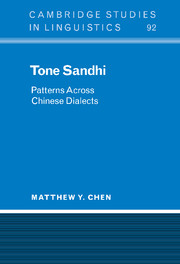Book contents
- Frontmatter
- Contents
- Preface
- Notational conventions
- 1 Setting the stage
- 2 Tonal representation and tonal processes
- 3 Directionality and interacting sandhi processes I
- 4 Directionality and interacting sandhi processes II
- 5 From base tones to sandhi forms: a constraint-based analysis
- 6 From tone to accent
- 7 Stress-foot as sandhi domain I
- 8 Stress-foot as sandhi domain II
- 9 Minimal rhythmic unit as obligatory sandhi domain
- 10 Phonological phrase as a sandhi domain
- 11 From tone to intonation
- Concluding remarks
- Bibliographical appendix Tone sandhi across Chinese dialects
- References
- Subject index
- Author index
5 - From base tones to sandhi forms: a constraint-based analysis
Published online by Cambridge University Press: 24 October 2009
- Frontmatter
- Contents
- Preface
- Notational conventions
- 1 Setting the stage
- 2 Tonal representation and tonal processes
- 3 Directionality and interacting sandhi processes I
- 4 Directionality and interacting sandhi processes II
- 5 From base tones to sandhi forms: a constraint-based analysis
- 6 From tone to accent
- 7 Stress-foot as sandhi domain I
- 8 Stress-foot as sandhi domain II
- 9 Minimal rhythmic unit as obligatory sandhi domain
- 10 Phonological phrase as a sandhi domain
- 11 From tone to intonation
- Concluding remarks
- Bibliographical appendix Tone sandhi across Chinese dialects
- References
- Subject index
- Author index
Summary
Tonal alternations in many well-documented dialects of Chinese seem to instantiate essentially “fortuitous” and “arbitrary substitutions” of one tone by another, a phenomenon that bears little resemblance to the familiar processes of assimilation, dissimilation, or simplification (equivalently, spreading, delinking etc.). Whatever phonetic and/or functional motivations such alternations once had must have faded into the nebulous past. At first blush, the facts of New Chongming presented en bloc in the Appendix look rather daunting, and appear to reinforce this general impression. I will show that upon closer inspection, the complex set of facts not only yields to a straightforward description in terms of standard rewrite rules (see Chen 1991c), but in fact lends itself to a reasonably explanatory treatment in a constraint-based approach. The principal appeal of a constraint-based approach lies in its insistence that what often are stated as arbitrary language-specific rules can be best explained in terms of, and in effect reduced to, general constraints on optimal outputs. Instead of simply formulating a set of transformational rules to crank out the correct sandhi forms, I will attempt to render an account of the facts by appealing to a set of general principles. The basic idea is this: while the rich underlying tone system of New Chongming potentially gives rise to a large repertoire of sandhi patterns when tone-carrying syllables combine into lexical compounds, the “tonotactics” of the language rejects all but a tiny fraction of the logically possible tonal combinations.
- Type
- Chapter
- Information
- Tone SandhiPatterns across Chinese Dialects, pp. 174 - 218Publisher: Cambridge University PressPrint publication year: 2000



